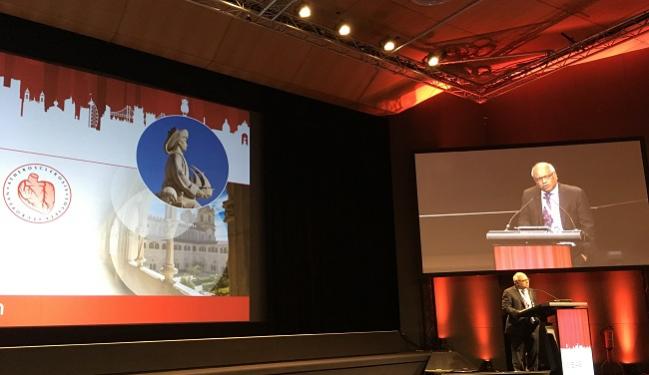Biology in the Back Seat: EAS 2018 Opens With Calls for a Big-Picture Approach to CVD Prevention
Given the known economic and social issues, experts agree that prevention efforts on a global scale need to take a wider view than lipid-lowering drugs.

LISBON, Portugal—Preventing cardiovascular disease on a global scale will require a big-picture view that includes behavioral and cultural shifts and not just new medications, according to the international group of experts who kicked off the opening plenary at the European Atherosclerosis Society (EAS) 2018 meeting.
The type of change that will be needed to prevent adverse cardiac events as well as cardiac death relates to convincing both patients and physicians to act before any action seems necessary, according to Valentin Fuster, MD (Icahn School of Medicine at Mount Sinai, New York, NY), who gave the first talk during the session.
“We are very, very clever at hiding our realities when we are at a certain age, particularly advanced age, and we feel well,” he said. “We do not believe that we’re in trouble.”
Additionally, Fuster argued, the pathway to cardiovascular disease begins much earlier—in people as young as 15 according to data he showed from various population studies. “We don’t take care of the young people, because we don’t believe it’s a problem” for them, he said. In fact, “the problem is huge.”
Despite the apparent gaps in treatment for patients at every age, Fuster said he feels “very optimistic” that the field of prevention is now being “approached scientifically.” But this will take a fundamental shift in focus, he suggested. “We know more about disease than about health. We don’t know what health is about.”
Environment and Health
But a deeper understanding of cardiovascular disease is also warranted, according to Salim Yusuf, MD (McMaster University, Hamilton, Canada), whose talk was dedicated to discerning the “causes of the causes” of cardiovascular diseases. The key to prevention lies in environmental and social factors, which are “much more important than biology,” he asserted.
Yusuf pointed out that the rates of major cardiovascular disease are highest in low-income countries despite those regions having the lowest prevalence of risk factors, and vice versa. Additionally, nonmajor cardiovascular disease is also more common in richer countries, but that could just be because physicians there are better able to screen for it. “We are detecting disease earlier in the rich countries,” Yusuf said. This makes sense given that antiplatelet agents, beta-blockers, ACE inhibitors or ARBs, and statins are consistently used less in lower-income countries, he added.
“What is the point of big biological advances if they cannot be afforded by the majority of the world?” Yusuf asked.
Looking at low-income regions specifically, he said the biggest barriers to hypertension control and secondary prevention include a reluctance to use combination drugs/statins, reluctance to use any drugs when blood pressure is controlled, the high economic and opportunity cost of traveling to doctor appointments, limited drug inventory, and substandard medications. One solution? Governments need to be involved in creating new health systems that send nonphysician health workers to patients’ homes for both consultations and prescriptions, Yusuf proposed.
Low-income countries are also at a disadvantage when it comes to tobacco, which is advertised with few regulations and easily purchased. The same countries also face poor air quality and a scarcity of healthy foods. Citing a recent study linking indoor air pollution related to the use of solid versus clean fuel sources to an increase in the risk of cardiovascular disease and death, Yusuf drove his point home. A switch in these countries to clean versus solid fuel would yield a benefit “the same as what PCSK9 inhibitors did at the end of their 3-year trials,” he said. But unlike expensive medications which help a minority of patients in first-world countries, a switch to clean cooking and heating fuel would affect 3.5 billion people.
Urging the EAS meeting organizers to devote more attention to these issues at future conferences, Yusuf concluded that “as much attention needs to be paid to the environmental determinants of risk factors of cardiovascular disease as we do to biological determinants.”
Stress and CVD
Viola Vaccarino, MD, PhD (Emory University, Atlanta, GA), speaking during the same session, turned the conversation to stress and how this seemingly indefinable condition can affect heart disease risk.
“Why is stress so important to consider?” she asked. It’s highly prevalent, has a large impact on the overall population, and offers a great potential for intervention. However, the cause and effect relationship is hard to prove given that past studies have been observational and relied on self-reported measures, that established criteria are lacking, and that “stress as a trigger is hard to predict,” Vaccarino said.
Stressors that affect people when they are young and increase throughout their lifetime have proven informative, she said. Similarly, mental health disorders like depression and posttraumatic stress disorder can also help clarify the link between stress and cardiovascular disease more clearly. Past studies have shown that mental stress-induced myocardial ischemia is “clinically distinct” from exercise-induced ischemia, and also that young women are more likely to experience this kind of myocardial ischemia, Vaccarino noted.
“We should abandon the concept that there is a separation between mental and physical health because there is shared pathophysiology,” she said. Future studies should focus on vulnerable populations, the life course impact of stress, stress-induced ischemia as a trigger of ACS, daily-life exposures and their consequences, as well as the efficacy of targeted stress-reduction techniques, Vaccarino concluded.
Yael L. Maxwell is Senior Medical Journalist for TCTMD and Section Editor of TCTMD's Fellows Forum. She served as the inaugural…
Read Full BioSources
Fuster V. Imaging and CVD risk estimation (population studies). Presented at: EAS 2018. May 6, 2018. Lisbon, Portugal.
Yusuf S. Lessons from epidemiology and environmental CVD risk factors. Presented at: EAS 2018. May 6, 2018. Lisbon, Portugal.
Vaccarino V. Stress, behavior and cardiovascular disease. Presented at: EAS 2018. May 6, 2018. Lisbon, Portugal.


Comments